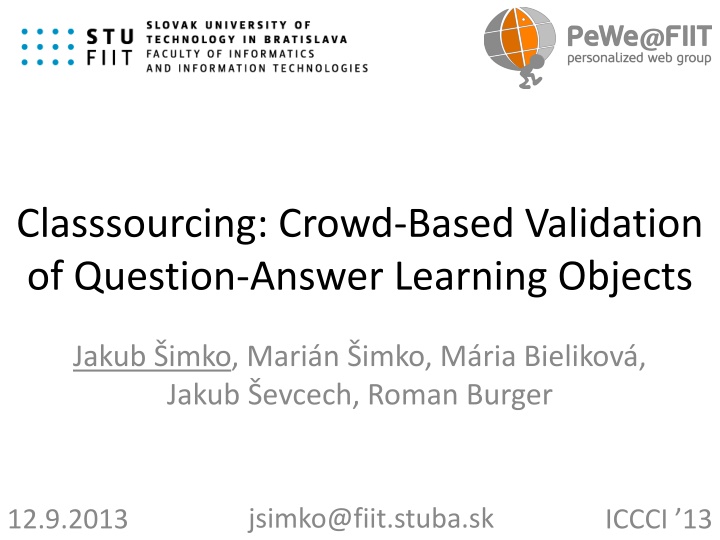
Utilizing Student Crowdsourcing for Learning Validation
Explore the concept of using student crowdsourcing to enhance the learning process, examining the advantages, challenges, and methods involved. Discover examples like Duolingo and ALEF, and delve into a method focused on online interactive exercises for effective learning reinforcement.
Download Presentation

Please find below an Image/Link to download the presentation.
The content on the website is provided AS IS for your information and personal use only. It may not be sold, licensed, or shared on other websites without obtaining consent from the author. If you encounter any issues during the download, it is possible that the publisher has removed the file from their server.
You are allowed to download the files provided on this website for personal or commercial use, subject to the condition that they are used lawfully. All files are the property of their respective owners.
The content on the website is provided AS IS for your information and personal use only. It may not be sold, licensed, or shared on other websites without obtaining consent from the author.
E N D
Presentation Transcript
Classsourcing: Crowd-Based Validation of Question-Answer Learning Objects Jakub imko, Mari n imko, M ria Bielikov , Jakub evcech, Roman Burger jsimko@fiit.stuba.sk 12.9.2013 ICCCI 13
This talk How can we use crowd of students to reinforce the learning process? What are the upsides and downsides of using student crowd? And what are the tricky parts? Case of a specific method: interactive exercise featuring text answer correctness validation
Using students as a crowd Cheap (free) Students can be motivated The process must benefit them Secondarily reinforced by teacher s points Heterogeneity (in skill, in attitude) Tricky behavior
Example 1: Duolingo Learning language by translating real web Translations and ratings also support the learning itself
Example 2: ALEF Adaptive LEarning Framework Students crowdsourced for highlights, tags, external resources
Our method: motivation Students like online interactive exercises Some as a preferred form of learning Most as self-testing tool (used prior to exams) but these are limited They require manually-created content Automated evaluation is limited for certain answer types OK with (multi)choice questions, number results, BAD with free text answers, visuals, processes, limited to certain domains of learning content
Method goal Bring-in interactive online exercise, that 1. Provides instant feedback to student 2. Goes beyond knowledge type limits 3. Is less dependent on manual content creation
Method idea Instead of answering a question with free text, student evaluates an existing answer The question-answer combination is our learning object.
This form of exercise Uses answers of student origin Difficult and tricky to be evaluated, thus challenging Enables to re-use existing answers Plenty of past exam questions and answers Plenty of additional exercises done by students Feedback may be provided By existing teacher evaluations By aggregated evaluations of other students (average)
Deployment Integrated into ALEF learning framework 2 weeks, 200 questions (each 20 answers) 142 students 10 000 collected evaluations Greedy task assignment We wanted 16 evaluations for each question- answer (in the end, 465 reached this). Counter-requirement: one student can t be assigned with the same question for some time.
Some students are more motivated than others: expect a long tail 500 450 400 350 300 250 200 150 100 50 0 137 1 9 105 113 121 129 41 17 25 33 49 57 65 73 81 89 97
Crowd evaluation: is the answer correct or wrong? Our first thought: (having a set of individual evaluations values between 0 and 1): Compute average Split the interval in half Discretize accordingly didn t work well trustful student effect
Example of a trustful student 120 100 80 60 40 20 0 0,1 0,2 0,3 0,4 0,5 0,6 0,7 0,8 0,9 1 0 0,1 0,2 0,3 0,4 0,5 0,6 0,7 0,8 0,9 Estimated correctness (intervals) True ratio of correct and wrong answers in the data set was 2:1
Example question and answer Question: What is the key benefit of software modeling? Seemingly correct answer: We use it for communication with customers and developers, to plan, design and outline goals Correct answer: Creation of a model cost us a fraction of the whole thing
Interpretation of the crowd Wrong answer 0 1 Correct answer 0 1 Correctness computation Average Threshold Uncertainty interval around threshold
Evaluation: crowd correctness We trained threshold (t) and uncertainty interval ( ) Resulting in precision and unknown cases ratios t = 0.0 79.60 (0.0) = 0.05 83.52 (12.44) = 0.10 86.88 (20.40) 0.55 0.60 82.59 (0.0) 86.44 (11.94) 88.97 (27.86) 84.58 (0.0) 87.06 (15.42) 91.55 (29.35) 0.65 0.70 80.10 (0.0) 88.55 (17.41) 88.89 (37.31) 0.75 79.10 (0.0) 79.62 (21.89) 86.92 (46.77)
Aggregate distribution of student evaluations to correctness intervals
Conclusion Students can work as a cheap crowd, but They need to feel benefits of their work They abuse/spam the system, if this benefits them Be more careful with their results ( trustful student ) Expect long-tailed student activity distribution Interactive exercise with immediate feedback, bootstrapped from the crowd Future work: Moving towards learning support CQA Expertise detection (spam detection)
